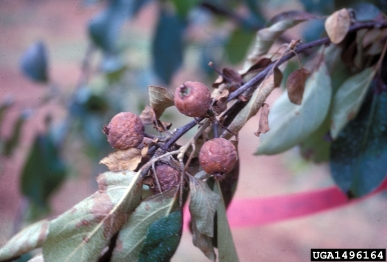Fireblight
Natural History

Fireblight on apple (Malus sp.)
Photo credit: University of Georgia Plant Pathology Archive, University of Georgia, Bugwood.org
Fireblight is a disease of trees in the rose family (Rosaceae) caused by a bacterium (Erwinia amylovora). Fireblight is particularly damaging to fruit trees (pears, cherries, apples etc.) and ornamentals (hawthorne, flowering pear and crabapple). The pathogen overwinters in affected host tissue and during warm, wet conditions in spring, the bacteria are transmitted by bees, wasps (and other insects), rain splash and by humans on pruning tools. The bacteria enter through wounds and flowers and cause death to flowers, fruits, leaves and stems. The affected tissues turn black – hence, the name "fireblight." Fireblight is a serious problem in nurseries, ornamentals and fruit orchards. Control involves sanitation (clean pruning tools), resistance and sometimes, anti-biotics.
